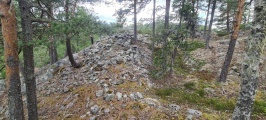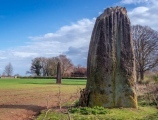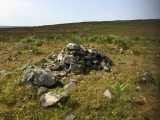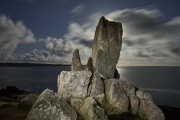Andy Burnham's Blog, page 6
September 30, 2025
Corndon Hill 8
Close to Mitchell's Fold stone circle, this is one of many cairns upon the summit of Corndon Hill. This one is easily visible from the bottom of the hill - a beautiful place to sit and take in the view. Lots more photos on our page.
Published on September 30, 2025 02:55
September 28, 2025
Wascana Lake Aboriginal Four Direction Medecine Wheel
A reconstructed Medicine Wheel built in the Regina Plain Native Prairie Restoration Site area of the Wascana Lake and the First Nations University. The four directions symbolize wholeness in the four stages of life’s journey.
Published on September 28, 2025 13:13
Naemforsen
When I was last in Ångermanland I was lucky enough to get to know to a guy who introduced me to ancient housekeeping, such as making cooking materials from birch bark etc. He also showed me how a large moose trap was built in ancient times. I love the many rock art panels showing moose and other game here!
Published on September 28, 2025 05:41
Holyhead Eisteddfod Gorsedd Circle
Published on September 28, 2025 05:27
September 27, 2025
Brustigåsen
In a beautiful location on a hilltop in Buskerud, Norway overlooking the valley to the east. From the main road a small drivable dirt road that leads to some old cobolt mines. Halfway to the mines a small but well marked footpath leads up to the hillfort.
Published on September 27, 2025 10:51
September 24, 2025
The Megalithic Portal's Top 15 Stone Rows in England
Something we did in our book The Old Stones, was to attempt objective ratings of the best of various types of megalithic monuments to visit in Scotland, England, Wales and Ireland. We did this by analysing numbers of visits, and ratings left for the various sites by visitors to the Megalithic Portal. Here is one of the lists we worked out - a run down of the best stone rows to visit in England - featuring many wonderful Dartmoor examples, and others you may not know.
Published on September 24, 2025 08:58
Roman inscription at Boldog
At first sight you might easily overlook this stone, especially compared with the imposing remains of Roman monuments elsewhere. But its significance becomes clear once we consider the broader historical context - it lies some 30 kilometres beyond the former Roman frontier, north of the Danube, within what was once regarded as Teutonic tribal territory.
Published on September 24, 2025 08:51
Hovenweep - Cutthroat Castle
One of the Hovenweep sites in Colorado. The Cutthroat Group also appears to have a large number of kivas (ceremonial Puebloan structures) relative to other building types.
Published on September 24, 2025 07:47
Drannandow S
It is a general rule of thumb that the impressiveness of a site is inversely proportional to the difficulty in reaching it. This relatively well-preserved long cairn in Galloway is reached by a c. 2 mile walk along reasonable tracks. The nearby cairn at Drannandow S requires a further 600 yards detour S over rough moorland to a small grassy mound topped by a shepherds cairn. Driving directions and my walking route are available on the main page.
Published on September 24, 2025 06:41
September 23, 2025
Le Doigt de Dieu
The Finger of God, a natural mass of rock in Finistère sculptured by erosion. About 1 km W of Port Manec'h on the rocky cliff facing the Atlantic ocean.
Published on September 23, 2025 09:36













